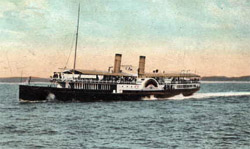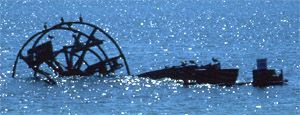|
||||||
|
|
||||||
|
|
The one hundred year history of the Port Phillip bay excursion steamers lasted from 1842 until 1942. From small beginnings, with such ships as the Black Eagle and the Express, which were used as excursion steamers in the summer months of 1854, to the 'big three' purpose built ships, the Ozone, Hygeia and Weeroona, which dominated the trade at the turn of the century. Their stories are varied and a rich field for study.
The ship which heralded in the 'Golden Era' was the Ozone. The benchmark by which all subsequent steamers were measured.
With the development of the excursion trade, the bayside ports also grew. Towns such as Sorrento, Mornington, Queenscliff and Portarlington became popular for a Sunday visit or a holiday, and a 'trip down the Bay' became quite an event. For the fashionable rich, a holiday at Portsea or Sorrento was an escape from Melbourne's summer heat. Many entrepreneurs made their fortunes by providing, not only the bay steamers, but also the hotels with which to house their guests. One such man, George Coppin, who, in the mid 1880s, raised money to form the Bay Excursion Steamers Co. Ltd. and commissioned the construction of the Ozone. Built near Glasgow, Ozone was 260ft in length, 28ft in width and 11.2ft in depth and was 572 tons gross, 241 tons net. She had a green hull, white superstructure topped by two orange funnels, three decks which contained a dining room, bars, a ladies' salon and many luxuries, all of which were lit with the new electric light. The Ozone's power plant was her direct-acting diagonal compound engines which were fuelled by six navy-type boilers. These drove its 21ft l0in paddle wheels at a speed of 20 knots. The Ozone left the United Kingdom on 25 August, 1886, for its delivery voyage to Australia, under the command of Capt. John McLean. The voyage took the Ozone through the Mediterranean Sea, the Suez Canal, the Indian Ocean to Thursday Island, where she was quarantined. The final run to Melbourne was made along the eastern Australian coast. The Ozone completed her voyage on Friday 26 November 1886 to an enthusiastic welcome. Her first commercial voyage took place in December of the same year. Ozone earned the name 'The Greyhound of Port Phillip' because of her speed. The era of the bay steamers was also the era of the trade picnics. A firm would charter the Ozone, or one of the other bay steamers, and the employees would enjoy a day on the bay. For many, especially the children, this was the highlight of the year. There was also competition between the rival ships and the companies which owned them. In 1888, the famous race on Port Phillip took place between the Bay Steamers Ltd. propeller-driven Courier and the paddle-driven Ozone. The Ozone was stripped, cleaned and put back into racing trim by her owners and easily beat the Courier. The following year, the return bout took place - this time the Courier was put into racing trim. As the expected race was just getting started, the Ozone glided to a halt, as its captain followed his orders and did not re-race his rival. The debate as to who won still continues. The Ozone was involved in three major incidents in her long career. These came before the Marine Board of Inquiry. In 1889, she collided with the schooner Elfin and in 1890 there was a near miss with the Coogee. In 1894 the Ozone ran down the fishing vessel May. With the arrival of the Hygeia in 1890, and the large and fast Weeroona in 1910, the Ozone's decline began. There was not enough patronage for three big excursion steamers, and in 1918, the Ozone was withdrawn from service. In 1925 her fittings were put up for auction and the hull was sold to the firm of George and Hill for breaking up. Stripped of everything but the paddle wheels and boilers, the hulk was finally sold to Capt. W.G. Forbes to be sunk as a breakwater at Indented Head. The plan to sink it end on to the shore came unstuck when a fierce north easterly wind caused her to slew parallel to the shore and she stuck fast in shallow water. A few years after her scuttling, fire broke out and destroyed what was left of her. For many years, all that could be seen above the water were the tops of her three after boilers and her paddle wheels. These were used by many holidaying children as jumping and diving platforms during the summer months. Below the surface, her rusting remains provide an artificial reef for the many and varied fish to find a home in.
In 1989, members of the Maritime Archaeological Association of Victoria (MAAV) dived the wreck of the Ozone in order to assess the remains of the vessel and begin to produce a site plan. A follow-up dive was conducted in 1991. The Ozone's rudder stock was measured in January of 1993, and in March of the same year, a detailed site plan was attempted. Due to conditions of severe silting, it was decided a further survey would be needed. April 1995 saw MAAV members Terry Arnott, Malcolm and Cate Venturoni, Peter Charlesworth and Brad Duncan (MHU), back on the site and this time much more detailed work was carried out. Measurements were taken of the forward and aft sections, the boilers, the stern post and the paddle wheels. From this information, a detailed site plan is being drawn up. Time and the sea continue to take a toll on the Ozone's remains. In April 1991, the starboard paddle wheel collapsed, changing forever the configuration of the wreck. On the cliff, overlooking the site, a small memorial is erected. This consists of one of the Ozone's anchors and plaques containing a brief history and details of the ship and her story.
References
Written permission from the M.A.A.V. is required for the publication of any material. Any use of this material should credit the Maritime Archaeology Association Of Victoria.
Last modified: January, 2011 |
|||||

